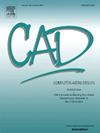非测地线细丝缠绕:基于矢量投影的一对弧长常微分方程的推导过程与求解
IF 3.1
3区 计算机科学
Q2 COMPUTER SCIENCE, SOFTWARE ENGINEERING
引用次数: 0
摘要
非测地线长丝缠绕允许制造各种旋转表面,包括那些曾经被认为不适合这个过程的表面,比如高斯凹点(即凹点),通过标准路径方程的数值解,而不需要巧妙的变通。在这种情况下,这些数学模型中的一个被彻底检查。它由一个弧长常微分方程组成,该方程专门应用于圆柱形几何。最初的求导技术是重复的,目的是用更一般的方式重新表述它,使用固有的微分几何概念。结果,得到了第二个方程,与期望的方程相似,但稍微复杂一些。为了通过与第一个方程的比较来验证其有效性,每个方程都被重新表述为两个微分方程的系统,这些微分方程在柱面坐标的帮助下定义了纤维增强的路径点的位置。选择了三种几何形状来验证数值解:一个右圆柱体,一个产生轴对称高斯凹陷的指数函数,以及一个勾勒出发散喷嘴轮廓的三次多项式。解决方案表明,这两个系统的方程产生稳定的,可预测的,和常规的结果,所有的几何形状,系统和解决策略。当分辨率为“前向”时(即自变量为绕组角α: dx/dα=α′−1),过程更加精细。相反,当分辨率是“逆”(α′)时,它是直接的。对于喷管,与基于表面测地线曲率和法曲率的另一种方法推导的方程进行比较,可以发现该方程沿α-轴的解范围更大,可以处理比文献报道的更高的摩擦系数值。因此,新导出的方程具有更强的全面性和适用性。结果表明,推导过程是明确的,这两个方程对改进纤维缠绕方法是有效的。本文章由计算机程序翻译,如有差异,请以英文原文为准。
Non-geodesic filament winding: Derivation process and resolution of a pair of ordinary differential equations in arc length based on vector projection
Non-geodesic filament winding allows the manufacturing of various surfaces of revolution, including those once considered unsuitable for this process, such as Gaussian depressions (i.e., concavities), through numerical solutions of standard path equations without the need for ingenious workarounds. In this context, one of these mathematical models is thoroughly examined. It consists of an ordinary differential equation in arc length that has been exclusively applied to cylindrical geometries. The initial derivation technique is repeated with the aim of reformulating it in a more general manner, using intrinsic differential geometry concepts. As a result, a second equation, similar to the desired one but slightly more complex, is obtained. To verify its validity through comparison with the first equation, each is restated as a system of two differential equations that define the position of the path points of the fiber reinforcement, with the aid of cylindrical coordinates. Three geometries are chosen to validate the numerical solutions: a right circular cylinder, an exponential function that produces an axisymmetric Gaussian depression, and a third-degree polynomial that outlines a divergent nozzle. The solutions show that both systems of equations yield stable, predictable, and conventional results for all geometries, systems, and solving strategies. When the resolution is “forward” (i.e., the independent variable is the winding angle : ), the process is more elaborate. In contrast, it is straightforward when the resolution is “inverse” (). Regarding the nozzle, comparison with an equation derived by another method, based on the geodesic and normal curvatures of the surface, reveals that the derived equation offers a broader solution range along the -axis and can handle higher friction coefficient values than those reported in the literature. Consequently, the newly derived equation demonstrates greater comprehensiveness and applicability. It is concluded that the derivation procedure is well-defined and that both equations are effective for advancing filament winding methods.
求助全文
通过发布文献求助,成功后即可免费获取论文全文。
去求助
来源期刊

Computer-Aided Design
工程技术-计算机:软件工程
CiteScore
5.50
自引率
4.70%
发文量
117
审稿时长
4.2 months
期刊介绍:
Computer-Aided Design is a leading international journal that provides academia and industry with key papers on research and developments in the application of computers to design.
Computer-Aided Design invites papers reporting new research, as well as novel or particularly significant applications, within a wide range of topics, spanning all stages of design process from concept creation to manufacture and beyond.
 求助内容:
求助内容: 应助结果提醒方式:
应助结果提醒方式:


